Dr. Pepe’s Diploma Casebook: Case 4 – SOLVED!
Dear Friends,
Abdominal films are being displaced nowadays by CT and US; but they are still useful if interpreted properly. In this case you are provided with a supine film of an 84-year-old man who has experienced epigastric pain, vomiting and abdominal distension for several days.
Possible diagnoses:
1. Pancreatitis
2. Pyloric obstruction
3. Perforated hollow viscus
4. None of the above
Findings: Dilatation of a small bowel loop and stomach (black arrows). A rounded, laminated calcified structure is present below the right colon (red arrow). A small air bubble is visible superimposed on the liver shadow (yellow arrow).
With the classic radiographic triad: small bowel dilation, possible ectopic gallstone, and suspicion of pneumobilia, the most likely diagnosis is gallstone ileus. CT confirms dilatation of bowel loops, showing an impacted calcified gallstone in the ileum (red arrows). CT also confirms the intrahepatic pneumobilia and distortion of gallbladder anatomy (blue arrows).
Final diagnosis: Gallstone ileus
Gallstone ileus can be suspected in abdominal plain films when a structure that looks like a calcified gallstone is seen outside the normal position of the gallbladder in association with pneumobilia and dilated bowel loops in patients with acute abdomen. Pneumobilia can be missed on plain films if scant air is present. Likewise, the ectopic gallstone might not be seen on plain films if it is poorly calcified or masked by intestinal gas or feces.
CT conclusively confirms gallstone ileus because it always shows the impacted small bowel gallstone, regardless whether or not it is calcified. CT clearly shows the size and exact location of the gallstone.
CT also confirms the other two findings of the classic triad of gallstone ileus: the anatomic distortion of the gallbladder area and the presence of air in the biliary tract, even when scant air is present.
It can be impossible to diagnose gallstone ileus on plain films because the ectopic gallstone and/or the air in the biliary tract may not be visible. In these cases, CT is necessary to reach the diagnosis.
A patient with acute abdomen. In the plain film, only dilated small bowel loops are seen (Fig. 4, white arrows).
No ectopic gallstones or pneumobilia are seen. CT confirms an impacted moderatly calcified gallstone in the ileum (Fig. 5, red arrow).
The differential diagnosis of ectopic calcified gallstone in plain films includes other common abdominal and pelvic calcifications like calcified mesenteric lymph nodes, appendicoliths, or calcified uterine leiomyomas. CT can easily differentiate among these calcifications.
A rounded calcified image incidentally detected in the pelvis on the plain film is clearly a uterine leiomyoma on CT.
Follow Dr. Pepe’s advice:
- Gallstone ileus can be suspected on plain films when the classic triad of intestinal occlusion, ectopic gallstone, and pneumobilia is present.
- In cases in which the ectopic gallstone or pneumobilia are not clearly seen on plain films, the diagnosis of gallstone ileus can be reached only by CT.
Suggested reading:
- Delabrousse E, Bartholomot B, Sohm O, et al. Gallstone ileus: CT findings. Eur Radiol 2000;10(6): 938-40
- Lassandro F, Romano S, Ragozzino A et al. Role of helical CT in Diagnosis of Gallstone ileus and Related Conditions. AJR 2005;185: 1156-1165
Case prepared by Julio Martin MD

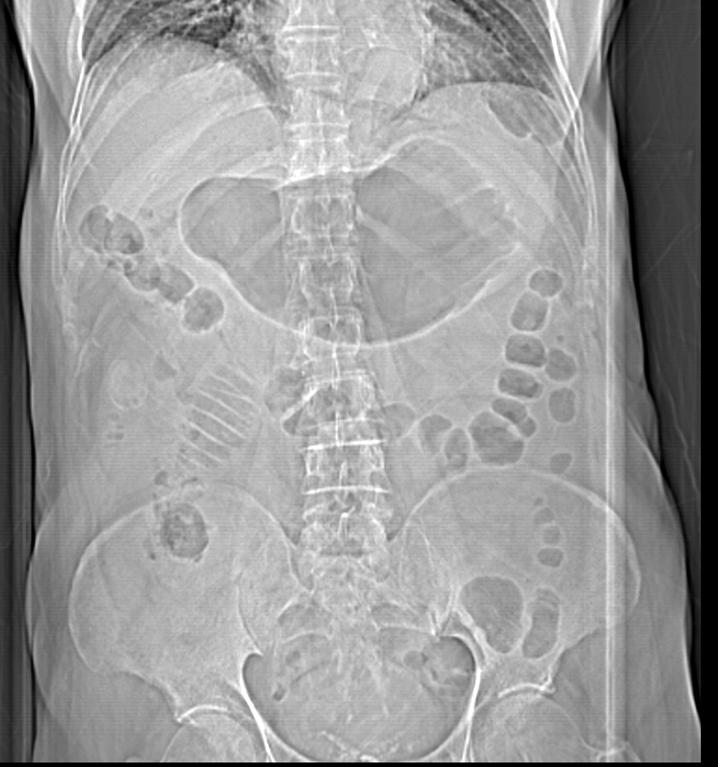
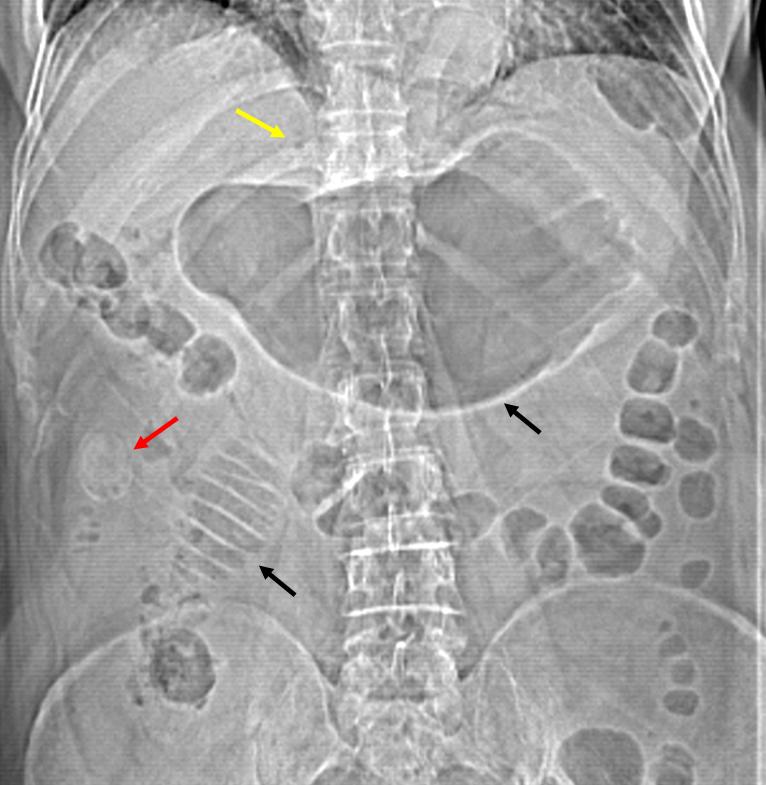
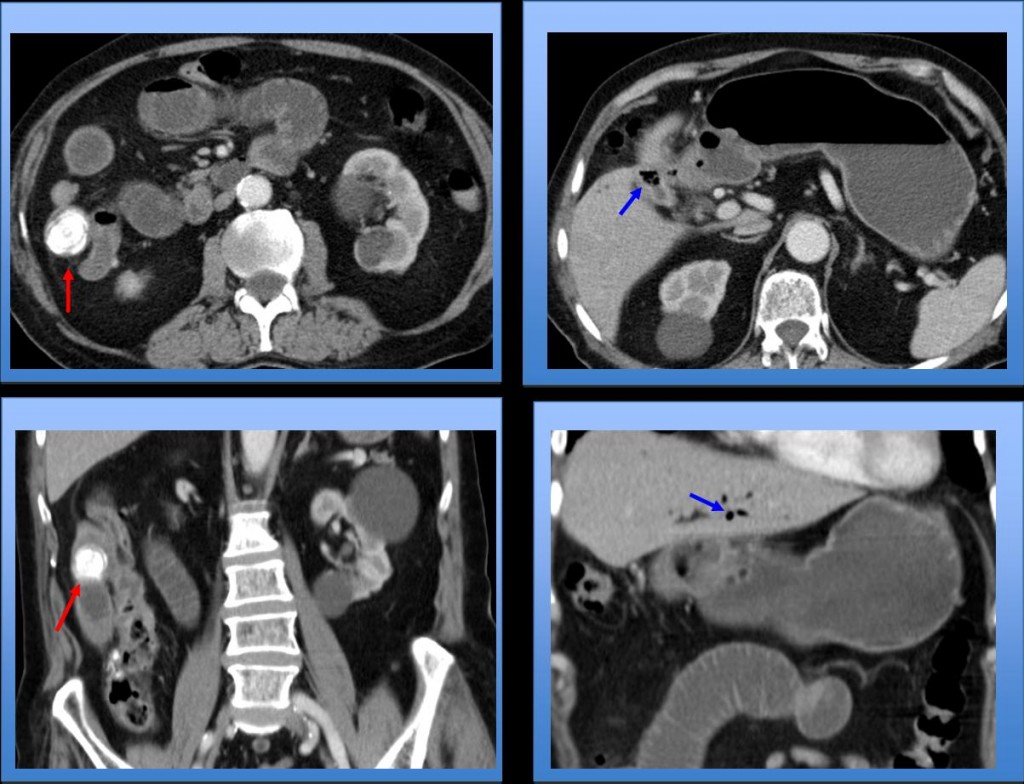
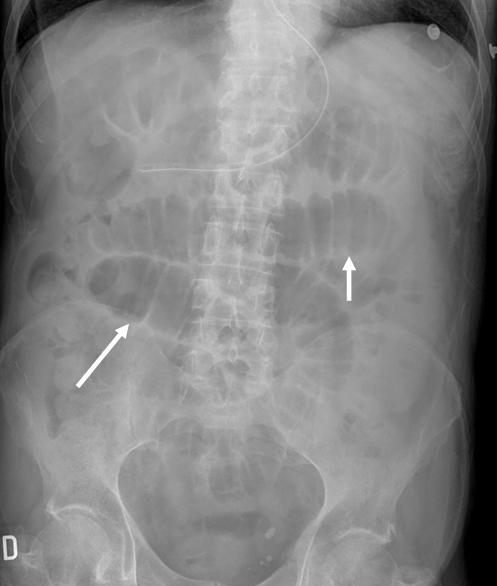
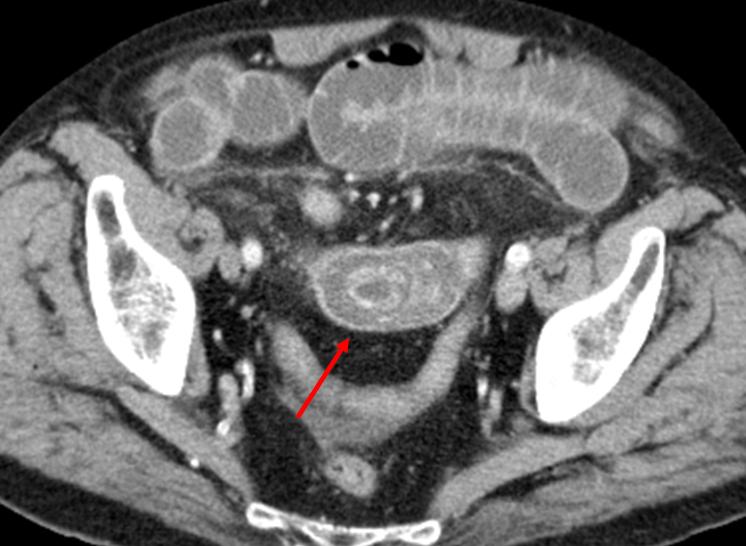
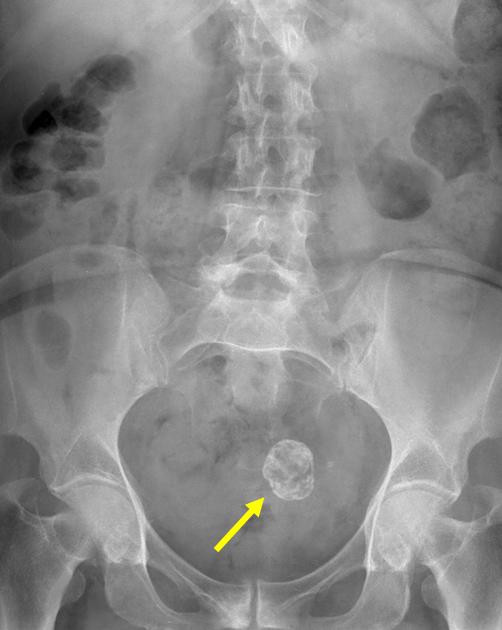
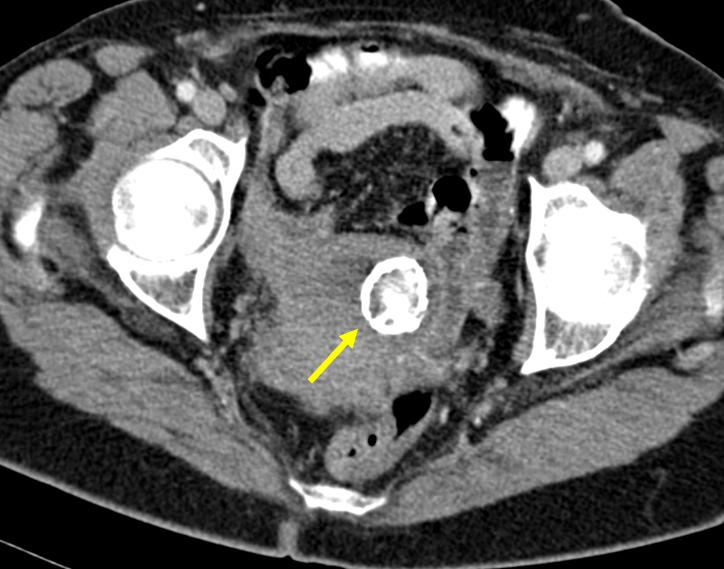



-The presence of intraluminal air in colon (normal distributed) discard the pyloric obstruction and make me think that the gastric image is a kind of gastroparesia.
-You can see well defined the ilio-psoas line so t seems no to be significant free fluid.
-There’s no pneumoperitoneum suggestive of hollow viscus perforation
-There’s a round density on right hypochondrium suggestive of colelitiasis. So in a patient with compatible symptoms it can be a biliar colic.
Option 4, none of the above.
There’s no pneumoperitoneum, so hollow viscus perforation it’s unlikely.
Pyloric obstruction wouldn´t be my choice, because there’s distal air in small and large bowel, although it could be an incomplete obstruction.
Pacient can have a pancreatitis, since it’a an analitic based diagnosis and Xray may be normal, but I don’t think it´s going to be the answer.
Estomach is dilated, and so is a small bowell loop on right side, close to the round calcium density (it´s not projected on the gallbladder area) so I can´t rule out a biliary ileum.
So I would choose no 4. None of the above.
Main findings on this plain abdominal radiograph:
mineral density caudal to the right hypochondrium
hint of biliary tree gas (central distribution – sparing periphery)
dilated segment of small bowel and distended stomach (though history gives a more convincing obstructive picture than the imaging does!)
Dr Pepe, I would really love to see this patient’s CT Scan!!!
Pneumobilia + SBO + Visible stone = Rigler’s Triad in Gallstone Ileus
My answer = 4 None of the above
Will show CT on Thursday. Hope you can wait that long…
There is no normal gas bouble in fornix of the stomach,and fornix looks thickened,indicates Neo or hiatus haernia?
There is a calcium stone shadowing in right subhepatic space,sugestive of bile stone…duoodenal loop is distended,sugest acute upper suboclusion or pancreatitis maybe
-”There’s no pneumoperitoneum suggestive of hollow viscus perforation” ???
It’s a supine film… I think ‘3’ is correct answer !
Gas within the urinary bladder wall…Rare condition found in diabetics…Emphysematous cystitis, I think…
Ileo biliare, da “migrazione” di calcolo rx-opaco in sede ilieale.
Well, i think that there is a genelaized lucency in the abdomen suggestive of free air, and since this is a supine film we are not able to see the cupola sign of pneumoperitoneum. However again i must say that both the internal and external walls of stomach are very well visualized. I am not sure whether this is a case of Rigler or not but , 2) there is radioopaque calcific density in Right hypochondrium as well and 3) moreover there are distended small bowel loops too in the presence of which i ll be very concerned with this overall lucency strengthning my suspicion of free air. 4) i ll be very interested to see if there is pneumobilia now but truly speaking even if its there i m unable to pick it and its very subtle.
I think this is a case of Gall stone ileus.
so it perforated hollow viscus.
I hope Dr Pepe doesnt have any thing very rare here ! I ll be a bit surprised with that Dr Pepe !
Dr. Pepe is a fair person. Good discussion, by the way.
4. None of the above
– gallstone ileus I think !
non f the above
i think of bowel ischemiaor mesentric ischemia there is sign dialated segment of small bowel
Pyloric obstruction . Dilated stomach, no significant air in the small bowel , normal air content in the large intestine. Chololith – big one, usually with no clinical Importance.
You are overlooking the dilated small bowel loop in the right flank. How do yo know that the so-called chololith is indeed a chololith?
Chiarisco meglio quanto ho già detto : calcolo colecistico, in sede “anomala, ” circondato da gas che Non è nel lume intestinale, ma libero , per migrazione del calcolo nel piccolo intestino, con perforazione “coperta” dalla reazione mesenteriale che “blocca” le bolle d’aria in “vicinanza” dell’ansa in sofferenza, per probabile necrosi della parete.
Dilated stomach and small bowell loop in the right flank, dense subhepatic oval image and probable air bubbles suggestive of pneumobilia.
I don’t clearly see an ileus, anyway can’t be sure with a supine projection (as far as I concern not useful projection to study occlusive episodes).
I dont see a double wall sign to think of perforation.
I would think of a biliary ileus or one of its variants: Bouveret Syndrome.
The CT topogram of abdomen showing moderately dilated small bowel loop in right lumbar region with a lamellated calcified density. Some air locules are seen adjacent to it with a soft tissue opacity in right lumbar region likely displacing the gut. No free air is seen in the abdomen. The properitoneal fat lines ,psoas shadows and pelvic fat planes are maintained-suggesting abscence of free fluid. There is colon cut off in the proximal transverse colon.No air is seen in rest of the small bowel loops. Small amount of air is seen in the colon with normal haustral pattern. x-ray findings are suggestive of fecolith with SBO. I am not sure of air in the biliary channels.The common causes of fecoliths are GB stones, appendicoliths or secondary to some foreign body or bezoars. based on clinical findings, the possibility will be of cholecystitis with gall stone within GB and few air loculi-emphysematous/gall stone ileus(common cause of fecolith but the points against are -not a typical location for terminal ileum and male patient although the site could be explained by bouveret syndrome-still it is more lateral for duodenum ). It could be appendicolith with appendicitis/appendicular tumor in retrocaecal location with SBO and colon cut off-but points against are big calcified density-appendicoliths are usually small and and lack of any pain in the right iliac region). Other causes like foreign body or bezoar can be excluded from the history.
Good discussion, as always. Lack of pain in right iliac region does not exclude appendicitis in an 86 y.o. man. Clinical symptoms may be vague.
dif.dg. maybe apendicolith or ureterolith vs. bile stone on the right?
I would say that it is too lateral to be in the urinary tract. Cannot exclude appendicolith; but it is too big (the mother of all apendicoliths!). Also, the air in right upper quadrant points to biliary ileus.